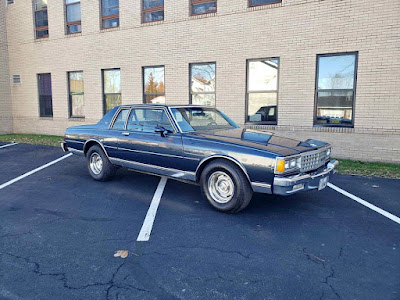General Motors "Class-of-1977", downsized full cars get an inordinate amount of praise from automobile cognoscenti that are of my age group and roughly ten-years older and younger. Not to be contrarian, but while I agree they were better transportation conveyances than what they replaced, aesthetically, there's not much of an argument they were nowhere near anything GM had come out with in the thirty-or-so-years prior. The dawn of the dutiful, disposable automotive appliance was upon us and for better, worse or indifference, with some exceptions, the automobile industry hasn't looked back. One of those most pleasant of exceptions was, my blog, my opinion, of all things, Chevrolet's 1980-1986 Chevrolet Caprice coupes. I found this 1982 for sale on Marketplace with a, "I guess the Pandemic is really, really over" asking price of $4,250.
Two-door sedans were quite fashionable after World War II and GM came with a full-range of them for the "Great Downsizing Epoch". While I'm partial to the 1977-1979 "D-body" Cadillac and Buick two-door sedans, giving credit where it's due, though, I have to applaud the efforts Chevrolet's design team for what they did on their B-body Caprice coupe. Doesn't mean I liked it, though. Above is a 1977 Impala.
The unique roof line of these cars has its fans, I'm not one of them. I don't get it and I think it looks out of place. My initial reaction to it was I thought it off-putting; they might as well have put tailfins on these cars. That far-out rear windshield was made by placing glass over hot-wires and slowly, literally, bending the glass over them. The process was time consuming, expensive and the failure rate was absurdly high.
Not surprisingly, come 1980 and GM's mid-cycle reboot of all of their full-size cars, the ambitious and pricy rear window or "backlight" was gone and was replaced with an all but bolt-straight roof treatment straight off the 1976-1979 Cadillac Seville. It also helped create my third favorite General Motors "1977" behind the aforementioned Cadillac deVille and Buick Electra coupes. Sometimes less really is more.
I actually like this bluebonnet so much that I know if I didn't have two "classics" already, I might lobby the wife for it. I mean, look at this interior! There's so much to work with here although there's much to be done, apparently.
Kudos to the poster of the ad who made the effort to photograph it so it looks, apparently, better than it is. Although the frame and pans are solid, there's rust issues. The driver's door has the tin worm, and the passenger door is so bad, they say it could or should be replaced. Well, again, snaps to the poster of the ad, you'd never be able to tell. Thanks for being so forthcoming.
It's got a busted brake line and although it runs and moves under its own power, it's sat since 1999 so it's going to need a good going over or two or three. Bring a trailer, literally and figuratively.
Under hood, the poster of the ad claims that's a "4.3 V6" but unless someone swapped in that engine, it can't be that. Chevrolet didn't offer the 4.3-liter V-6 on the Caprice until 1985, again, this is an '82, so if it is a V-6, that's Chevrolet's own 3.8-liter V-6 that's not to be confused with the Buick 3.8-liter chuffer of the era. The 4.3-liter V-6 replaced the 3.8-liter Chevrolet V-6.
It looks a tad long to be a V-6, though, sorry, that was the only picture of the engine in the ad, and since the poster said it was a "4.3", perhaps they're mistaking that for, "4.4"? In that case, and this makes sense, it would be Chevrolet's "L39", 4.4-liter V-8. Chevrolet made that boat anchor from 1979-1982. Also known as the "267-cubic inch V-8", it made 120-horsepower and 215-foot pounds of torque and it's most "powerful". Even in a "downsized" Caprice, you ain't going anywhere fast with it under the hood. Chevrolet also offered the 267 in the Monte Carlo and Malibu.
The reasonable asking price is also, I take it, reflective of the fact that this car doesn't have at least Chevrolet's vastly superior "LG4", 5.0-liter (305-cubic inch) V-8 which, for 1982 (engine choices above), made a fairly respectable 145-horspower and 245-foot pounds. The LG4 is also vastly tunable, the L39 is not, and there's an entire cottage industry devoted to making it more powerful.
Another Achilles heel this car has is its transmission. This probably has GM's infamous THM-200 which is a lightweight version of their venerable THM-350. I'd use the rust, the engine and the transmission as bargaining points. Given the interior and the frame being solid, this is very well bought closer to two-grand.
Take the savings and get the doors fixed and plop in a proper powertrain. Keep in mind, you don't have to "LS-swap" it. There's plenty of engine and transmissions out there that for very little money could transform this handsome blue bonnet into the sleeper of your dreams. Or nightmares.
1982 Chevrolet Caprice Classic 2dr Coupe, 4.3 v6 auto. The car runs and moves under its own power but currently has a bad brake line.
The car has sat since 1999 and could use a good going over before putting on the road.
Car is not perfect, it has some rust spots around the car, all rather small. The worst rust on the car is in the doors.
Passenger should be replaced, drivers could be fixed but its not great. Aside from that, the frame is 100% rot free, no cracks or holes. Trailing arm pockets are very solid. Floor pans, trunk pan, rockers, hood and deck lid are all very nice.
Best part of the car in my opinion is the interior, front and back seat are very nice, headliner is solid and the carpet is intact. With minimal cleaning it would be pretty darn nice.




















